Liverpool, Napoli, RB Salzburg and KRC Genk. When people saw that these four teams would be in group E in this season’s UEFA Champions League the most fans thought that Liverpool and Napoli would easily go through to the next round while Salzburg and Genk would fight for the third place to play in 2020 in the knockout stages of the UEFA Europa League. However, it was not until the last matchday when it was decided who would go through to the last 16 in the Champions League and who would need to continue in the Europa League. Genk was already out as they got just one point out of the opening five games. Anyway, Salzburg had seven, Napoli nine and Liverpool 10. Due to that, everything was possible ahead of the two final matches on the sixth matchday.
Even though Salzburg lost 2-0 against Liverpool, and are due to play in the Europa League next year because of that, the Austrians proved that they are ready to compete on the highest European level with the biggest clubs. One reason for their strong performances in the Champions League and the fact that they are once more league leaders in the Austrian Bundesliga is surely their American coach Jesse Marsch. Due to that, we’ll now look at his systems and tactics.
Different systems – same basic principles
Within the last years, you sometimes had the feeling that the coaches in Salzburg didn’t only bring in their own ideas but always used the tactics of how the club thought that the team should play. The fact that RB Salzburg have a real philosophy and idea how they want to play football has a big advantage because when a new coach arrives, he already has a basis and knows how the club wants to play football. On the other side, it’s logical that Salzburg just bring in coaches who also have the same idea of football as they have.
Besides the tactics which are typical for Salzburg, which we’ll look at in the next step, we mainly saw the Austrians using a 4-1-3-2 or 4-diamond-2 respectively within the last seasons. That is clearly one of the points which drastically changed since the arrival of Marsch. The American coach has also often used a 4-1-3-2, but also a 4-4-2 and in some games also a formation with a back three.
Regardless, the tactics mostly stayed the same. Salzburg want to play forward-thinking, offensive and entertaining football paired with an intense counter-pressing and high pressing as well as fast counterattacks in transition. These are already for a couple of years the general tactics of Salzburg and Marsch also continues this way, but we’ll now take a closer look at the single principles.
Even though he wants his team to play as fast as possible behind the last line of the opposition and create goal scoring chances with vertical, penetrating passes, the American coach knows that his team need good circulation of the ball within deeper areas to do that. Due to that, Salzburg always have at least three players who are positioned centrally in the deeper lines to play the ball from one side to the other until a vertical or diagonal passing option is available.
In these cases, we have already seen different shapes this season. Sometimes, one of the central midfielders drops between the centre-backs and in other situations, both central midfielders stayed central in front of the centre-backs. However, within the last few games, we also often saw the structure which can be seen in the image below. Due to several injuries, it was often the case that either Zlatko Junuzović or Mohamed Camara played as a single defensive midfielder ahead of the back four or back three. In the example below during one of their last league games against WSG Tirol, Camara positions himself in front of the back three to create a diamond. These four players of Salzburg always position themselves so that the single striker of the opposition is positioned in the centre of the diamond and due to that Marsch’s team can easily circulate the ball until they play either a vertical pass or to the wide areas.
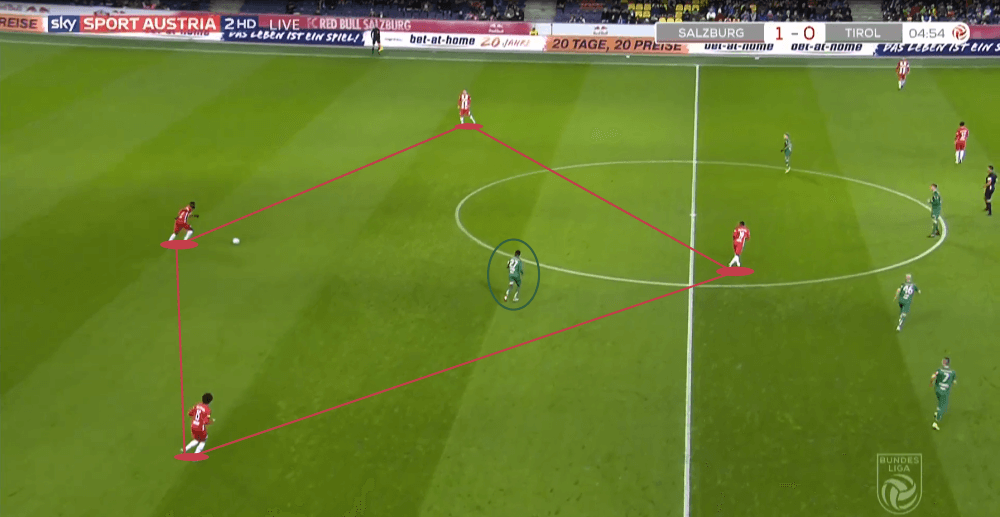
However, Salzburg want to get into the final third as fast as possible to either create goal scoring chances or to start counter-pressing when they lose the ball. Therefore, they also don’t hesitate to operate with long balls since these can often be the perfect trigger to start counter-pressing. For that, the wide players shift inside and the deeper midfielders (like in the shot below Camara) push forward to have enough men forward to win the second ball or start the counter-pressing respectively.
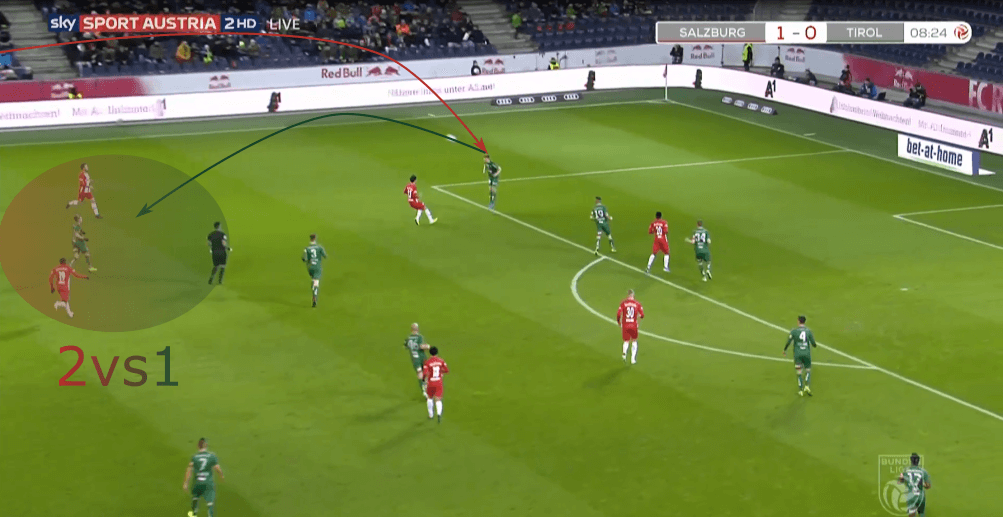
Another aspect of Marsch’s team which is outstanding is the intensity of their pressing. Due to Salzburg’s clever recruitment and youth system, they have players in the squad who fit into this idea of football as they have the physical and mental ability to execute such aggressive pressing. We’ll look at a certain pattern in the following paragraphs, but in general, it is amazing to watch with how many men Salzburg execute their (counter)-pressing high up the pitch. Depending on the build-up shape of the opposition, we often see a man-orientated approach as seen in the two images below. The first one is from the game against SKN St. Pölten in the Austrian Bundesliga while the second one is from the match versus Liverpool on the sixth matchday of this season’s Champions League group stage.
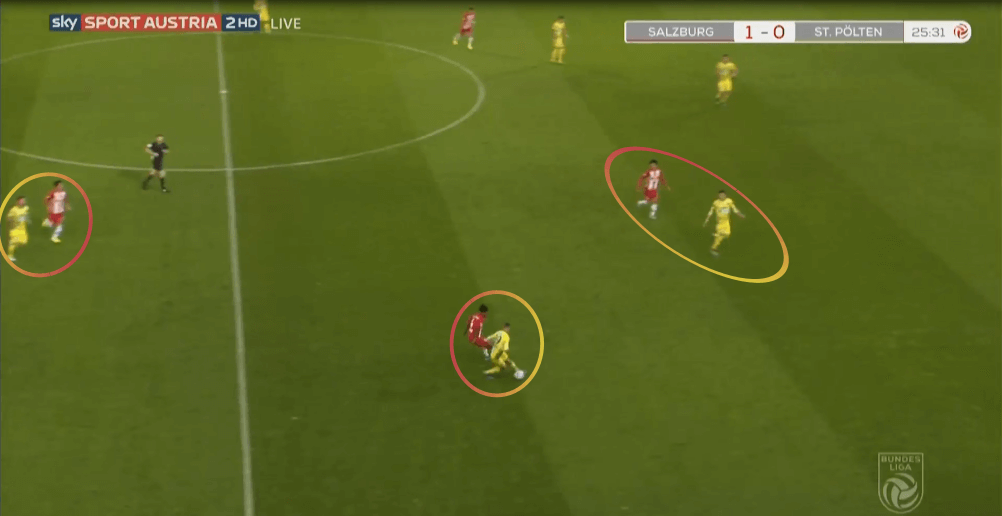
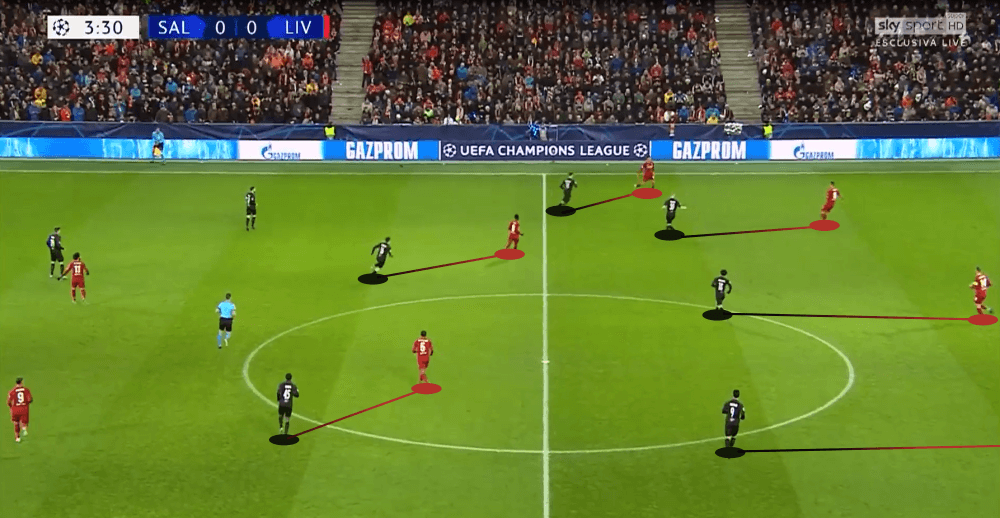
As a last point of the tactical principles, we’ll come back to the creation of goalscoring chances. We already looked at their structures during the first phase of the build-up and also discussed their counter-pressing (for example after long balls) and also their man-orientated pressing. Anyway, we’ll now see why, from a neutral point of view, it’s so enjoyable to watch the Austrian side: their forward-thinking and vertical style of play. No matter if during the build-up or moments of transition, Marsch’s team want to get in front of the opposition’s goal as quickly as possible.
To do so, they need enough players up front and in the higher lines respectively. We already mentioned that Salzburg used several systems throughout the season, however, they always operate with two strikers. Additionally, these two strikers get support from one or two offensive midfielders who try to move between the lines of the opposition. Takumi Minamino is often the only or one of the two offensive midfielders who position themselves between the lines.
Now, with two strikers, one or two highly positioned offensive midfielders and the offensive thinking full-backs (mostly Andreas Ulmer and Rasmus Kristensen), Salzburg have a lot of men in the higher lines. This has two reasons: firstly, to have several players up front who can start deep runs to receive through passes and, secondly, to immediately start the already mentioned counter-pressing high up the pitch. In the shot below we see such a typical situation in which Salzburg have many players in the higher lines and they try to use a vertical pass to penetrate the opposing defence.
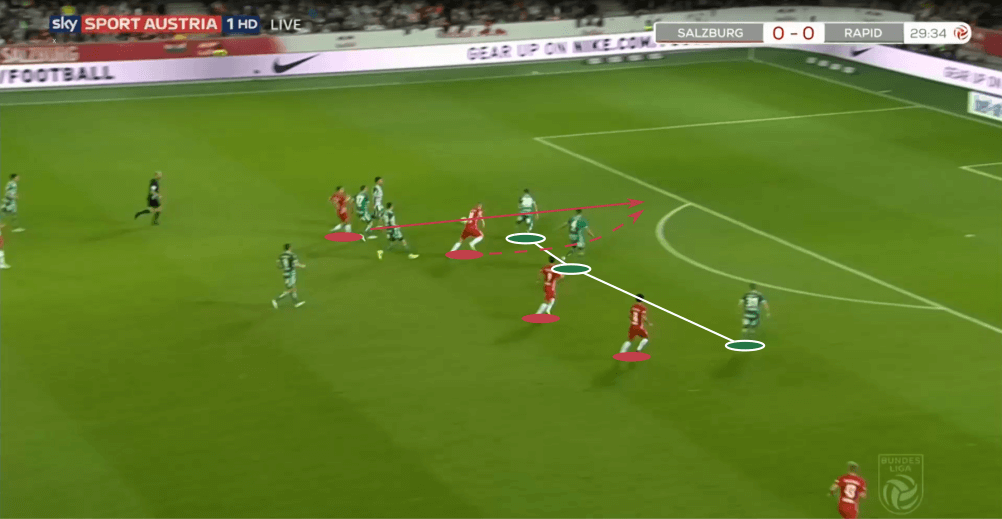
The different opponents
However, Salzburg have got one big problem which we can often see in Europe. Marsch’s team usually dominate the Austrian Bundesliga as they won the league nine times within the last 11 years and, in the other two seasons, they finished second twice. This season, they are currently first with 44 points from 18 games and are yet to lose. Usually, they would be the clear number one with so many points, but as LASK also plays an incredible season, they are just two points behind Marsch’s team at this point of the season.
However, the problem is now that the difference of the level of the opponents in the Austrian Bundesliga compared to the ones in the Champions League is so big. Additionally, you have to consider that this season was the first in which RB Salzburg played in the Champions League. This difference between the levels of the competitions also can be seen in the numbers and statistics.
While Salzburg concede on average just 0.94 goals per 90 minutes in their domestic league, for their six group stage games in the Champions League they averaged 1.89. Meanwhile, the difference between the number of goals they score per game is also quite big (3.76 in the domestic league and 2.67 in the UCL). However, the fact that they score on average 2.67 goals per match in the six games against teams like Liverpool, Napoli and Genk also proves that they use their vertical and offensive-thinking style of play against bigger clubs too. In the table below you can see some other values.

What gets clearly visible is that Salzburg also want to continue their style of play in the Champions League against the top teams of Europe and they are successful with it as they almost went through to the last 16. Anyway, since they’ll play in the knockout stage of the Europa League and in the next season either in the Europa League or in the Champions League, it is interesting to watch how Marsch’s team acted within the last weeks in the games in the Champions League. Considering this, we’ll now shortly analyse some aspects of the decisive game on the sixth matchday against Liverpool.
Playing against the big teams
As already mentioned, Salzburg often use a man-orientated pressing which we already saw in the two images above and one of them also showed a situation in the game against Liverpool. Salzburg’s two strikers mostly looked after the two opposing centre-backs, the number 10 Minamino followed Jordan Henderson while the three central midfielders behind the Japanese tried to mark Liverpool’s central midfielders and the full-backs. So, when the ball was played on one wing, the according central midfielder moved out to Liverpool’s full-back and the two other central midfielders in Salzburg’s 4-diamond-2 shifted over.
However, we also saw another pattern in some situations. When the ball was played on one side, the ball-near striker created a diamond with Minamino, the deepest central midfielder and the one on the wing. This can be seen in the image below. As soon as the ball was played to a player in the middle of these four players, they instantly put pressure on him to exploit their numerical advantage. Thus, despite Liverpool being the current Champions League holder, Salzburg didn’t hesitate to use their aggressive and brave pressing.
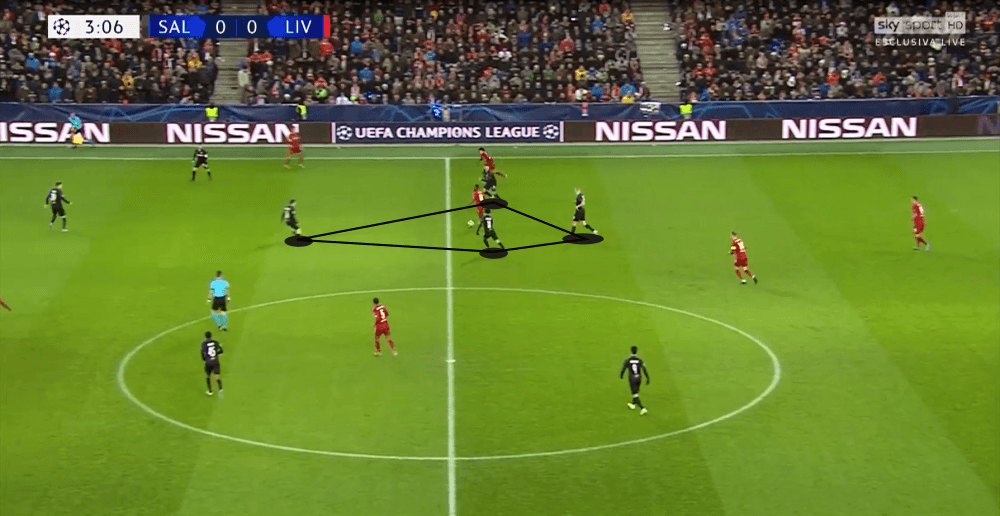
Meanwhile, that Salzburg scored 2.67 goals per game in the Champions League proves that they focus on the creation of goalscoring opportunities no matter who the opponent is. Even though they did not score against Liverpool, they had a lot of chances which their xG-value for this game, 1.52, proves. Marsch’s team created several chances with the aid of through passes behind the back four of Liverpool. Virgil van Dijk rescued his team in several situations with the aid of his pace and acceleration since otherwise, it could have been more frequently possible for Salzburg to get into one-on-one situations with Alisson Becker. Additionally, notice in the example below how many players Salzburg have upfront.
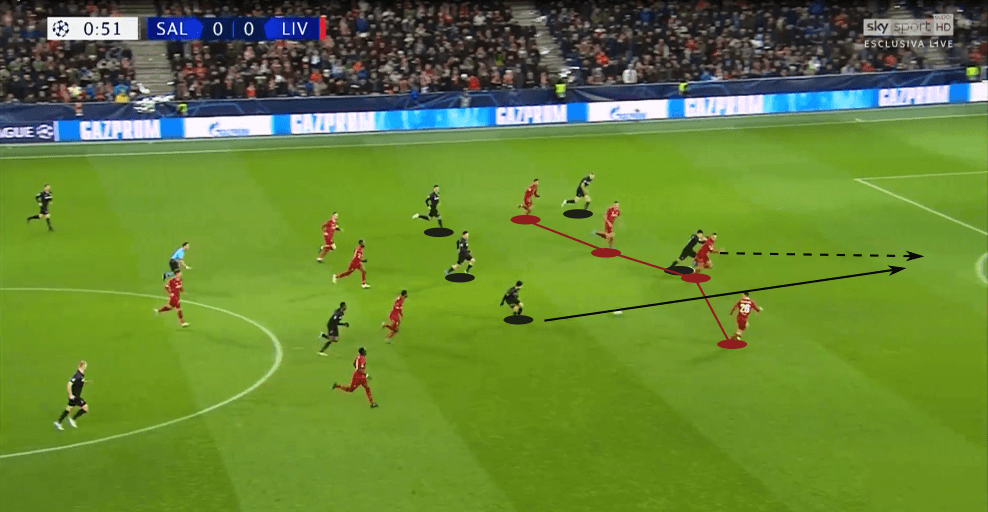
However, Liverpool won this game 2-0. They scored the two goals right after one another as the second one resulted from an individual error by Jérôme Onguéné and a masterpiece by Mohamed Salah. However, ahead of the first goal, Liverpool exploited one of Salzburg’s very few weaknesses of their 4-diamond-2 system.
When Marsch lines his team up in a 4-diamond-2 and a 4-1-3-2 respectively, they have a lot of players in the central area of the pitch. However, the full-backs are the only men who occupy the wide-areas. As already explained, the ball-near central midfielder mostly shifts to the outside to support the full-back.
However, ahead of the first goal, Trent Alexander-Arnold made one of his typical long balls to Andrew Robertson on the other wing to switch sides. This created a two-on-two and two-on-one situation respectively for Liverpool as Robertson used his pace to dribble past the central midfielder Enock Mwepu and therefore Kristensen had to decide if he would step out to put pressure on Robertson or follow Sadio Mané. In the end, Robertson passed the ball to Mané who then delivered a great cross which led to the goal.
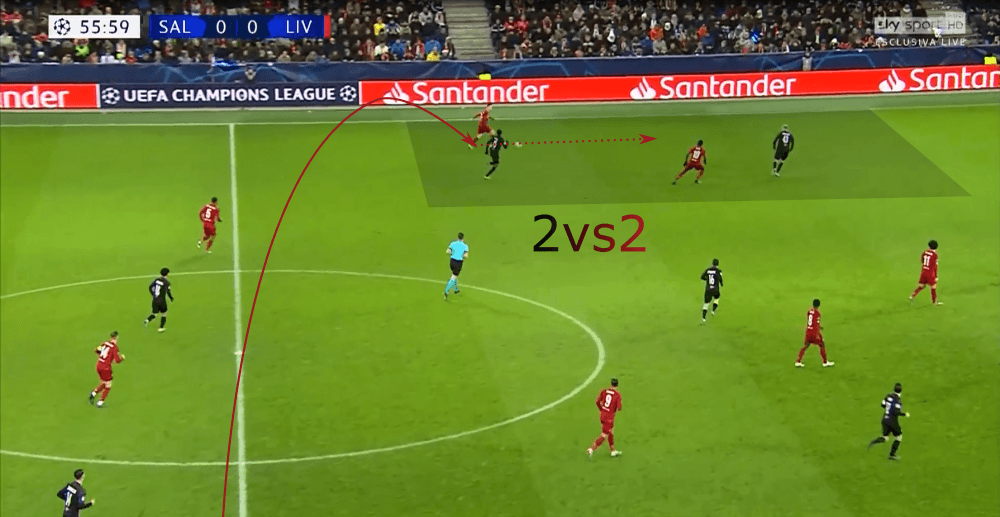
Normally, it doesn’t always make sense to analyse goals, but in this case, it gets visible that Liverpool exploited one little weakness in Salzburg’s system to beat them as they made use of the fact that Mwepu would need some time to shift from the left to the right since there Is no real winger in Salzburg’s system. It’s safe to say that almost no team in the Austrian Bundesliga could do so as they don’t have the individual quality Liverpool do. Here, we once more see the problem of Salzburg as they don’t compete every weekend on the level on which they then have to when they play in the Champions League.
Conclusion
Marsch perfectly fits into Salzburg as he has the same idea of football. It will be interesting to watch how his team will perform in the knockout stage in the Europa League while it seems as it could get thrilling in the Austrian Bundesliga title race for the first time in a long time as LASK also perform on a really high level.
However, from a neutral point of view, it’s always a joy to watch Marsch’s Salzburg as they play an interesting style of football. It’s just the first year of the American coach in Salzburg since he replaced Marco Rose. Who knows how long he’ll stay in Salzburg and what will be next for him? Former coaches of Salzburg like Adi Hütter and Rose showed that the Austrian city is the right place for a coach to develop his skill set before he moves on to join a bigger club.





Comments